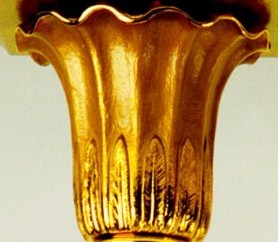Lost-wax casting (also called "investment casting", "precision casting", or cire perdue in French) is the process by which a duplicatemetal sculpture (often silver, gold, brass or bronze) is cast from an original sculpture. Dependent on the sculptor's skills, intricate works can be achieved by this method. The oldest known examples of this technique are the objects discovered in the Cave of the Treasure(Nahal Mishmar) hoard in southern Israel, and which belong to the Chalcolithic period (4500–3500 BCE). Conservative Carbon 14 estimates date the items to c. 3700 BCE, making them more than 5700 years old.[1][2] Though the process today varies from foundry to foundry, the steps used in casting small bronze sculptures are fairly standardized. (In modern industrial use, the process is called investment casting.) Variations of the process include: "lost mould", which recognizes that materials other than wax can be used (such as: tallow, resin, tar, and textile);[3] and "waste wax process" (or "waste mould casting"), because the mould is destroyed to remove the cast item.[4][5] Lost-wax casting was widespread in Europe until the 18th century, when a piece-moulding process came to predominate.

